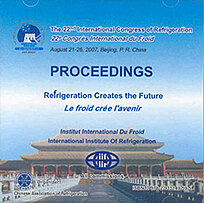
Summary
CFD simulation of a 1-row condenser in a domestic air conditioner is made. 2D models, with uniformly constant fin temperature overestimate significantly the heat transfer coefficient. 3D models, taking into account tube effects, conjugate heat transfer and conduction through the fin are in better agreement with the experimental results. A condenser experiment system is designed and built to validate the CFD result. Calculations are performed for different air frontal velocities and different condensation temperature. Even if an offset(less than 9%) of between CFD calculations and the experimental results, the trends are comparable and CFD study permits to reach local information, leading to better understanding of the physical phenomena involved in compact heat exchangers. The prediction outside the experiment range is discussed by performing a "numerical experiment". It is found that there is optimum fin space when other structural parameters of the tube-fin condenser are given, and there is optimum tube space when other structural parameters of the tube-fin condenser are given.
Available documents
Format PDF
Pages: ICR07-B1-1362
Available
Public price
20 €
Member price*
Free
* Best rate depending on membership category (see the detailed benefits of individual and corporate memberships).
Details
- Original title: CFD analysis of condenser in a domestic air conditioner.
- Record ID : 2008-0351
- Languages: English
- Source: ICR 2007. Refrigeration Creates the Future. Proceedings of the 22nd IIR International Congress of Refrigeration.
- Publication date: 2007/07/21
Links
See other articles from the proceedings (839)
See the conference proceedings
Indexing
- Themes: Comfort air conditioning
- Keywords: Household application; CFD; Air conditioner; Air-cooled exchanger; Air; Modelling; Flow; Air conditioning
-
Research on simulation and experiment of a dome...
- Author(s) : WANG J. F., WANG Y. H., TAO L.
- Date : 2007/08/21
- Languages : English
- Source: ICR 2007. Refrigeration Creates the Future. Proceedings of the 22nd IIR International Congress of Refrigeration.
- Formats : PDF
View record
-
Modeling of dynamic characteristics for a split...
- Author(s) : CHEN Z. J., SONG X. H., ZHANG C. L., QUE X. C.
- Date : 1997/09/09
- Languages : English
- Source: International Symposium on Air Conditioning in High Rise Buildings - 1997
- Formats : PDF
View record
-
Design of air-cooled R410A microchannel condens...
- Author(s) : SUBRAMANIAM V., GARIMELLA S.
- Date : 2005
- Languages : English
- Source: ASHRAE Transactions. 2005 Winter Meeting. Volume 111, part 1 + CD-ROM.
View record
-
A simplified regression building thermal modell...
- Author(s) : CUI B., DONG J., MUNK J., et al.
- Date : 2018/07/09
- Languages : English
- Source: 2018 Purdue Conferences. 5th International High Performance Buildings Conference at Purdue.
- Formats : PDF
View record
-
Analiza troskova tokom veka trajanja klimatizac...
- Author(s) : KHALIL E. E.
- Date : 2008/12/03
- Languages : Serbian
- Source: Zbornik radova. 39. Medunarodni kongres o grejanju, hladenju i klimatizaciji.
- Formats : PDF
View record
